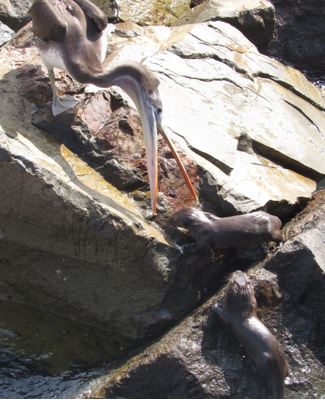Abstract
Observations about negative interaction between Lontra felina Molina 1782 (Carnivora: Mustelidae) and Pelecanus thagus Molina, 1782 (Pelecaniformes: Pelecanidae) are explained in the present note. Field work was carried out in the small fishing town of Morro Sama, at the Department of Tacna in Peru. Four interaction events were documented during 2015, 2017 and 2019 which occurred in the surrounding of the dens of L. felina or in sites where fishermen discard fishing remains.
References
Cassini MH. 2008. Present status of Lontra felina in Argentina. Endangered Species Update, 25(2), 57-60.
Cursach JA, Rau, JR, Ther, F, Vilugrón, J, & Tobar, CN. 2012. Sinantropía y conservación marina: el caso del chungungo Lontra felina en el sur de Chile. Revista de biología marina y oceanografía, 47(3): 593-597. http://dx.doi.org/10.4067/S0718-19572012000300022
Cursach JA, Rau, JR, Gelcich, S, & Rodríguez-Maulén, J. 2018. Situación poblacional del Pelícano Peruano (Pelecanus thagus) en Chile: prospección inicial. Ornitología Neotropical, 29(1): 77-89.
Duplaix N. & Savage M. 2018. The Global Otter Conservation Strategy. Salem, Oregon, USA: IUCN/SSC Otter Specialist Group.
Jefferson, TA, Webber, MA, Pitman, RL & Gorter, U. 2015. Marine mammals of the world: a comprehensive guide to their identification. Second edition. London: Academic Press.
Mangel JC, Whitty, T, Medina‐Vogel, G, Alfaro‐Shigueto, J, Caceres, C, & Godley, BJ 2011. Latitudinal variation in diet and patterns of human interaction in the marine otter. Marine Mammal Science, 27(2), E14-E25. https://doi.org/10.1111/j.1748-7692.2010.00414.x
Medina-Vogel G, Boher, F, Flores, G., Santibañez, A, & Soto-Azat, C. 2007. Spacing behavior of marine otters (Lontra felina) in relation to land refuges and fishery waste in central Chile. Journal of Mammalogy, 88(2): 487-494. https://10.1111/j.1469-1795.2007.00151.x
Medina-Vogel G, Merino, LO, Monsalve-Alarcón, R, Vianna, J. 2008. Coastal-marine discotinuities, critical patch size and isolation: implications for marine otter conservation. Animal Conservation 11: 57-64. https://doi.org/10.1644/06-MAMM-A081R1.1
Nelson B. 2005. Pelicans, cormorants, and their relatives. Oxford, U.K.: Oxford University Press.
Pizarro J. 2008. Mortality of the marine otter (Lontra felina) in southern Peru. IUCN Otter Specialist Group Bulletin 25(2): 94-99.
Pizarro J. 2014. La Nutria Marina en Tacna. Tacna: Proyecto Nuestro Medio Ambiente Marino.
Sullivan K., Bustamante, G. 1999. Setting Geographic Priorities for Marine Conservation in Latin America and the Caribbean. Arlington (VA): The Nature Conservancy.
Valqui J. 2012. The marine otter Lontra felina (Molina, 1782): A review of its present status and implications for future conservation. Mammalian Biology, 77(2): 75-83. https://doi.org/10.1016/j.mambio.2011.08.004
Valqui J. & Rheingantz, ML. 2015. Lontra felina. The IUCN Red List of Threatened Species 2015: e.T12303A21937779. http://dx.doi.org/10.2305/IUCN.UK.2015-2.RLTS.T12303A21937779.en Acceso 10 marzo 2021.
Zavalaga CB, Dell'Omo, G., Becciu, P., & Yoda, K. 2011. Patterns of GPS tracks suggest nocturnal foraging by incubating Peruvian pelicans (Pelecanus thagus). PloS one, 6(5), e19966. https://doi.org/10.1371/journal.pone.0019966

This work is licensed under a Creative Commons Attribution 4.0 International License.






